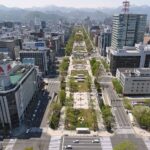Some of the best public transportation in the world is found in Guangzhou. It consists of a vast and reasonably priced network of buses, subways, and ferries. Over 50 bus lines and 16 subway lines serve the city, making it simple to move around and connect with other parts of it. Furthermore, Guangzhou is connected to neighboring cities including Shenzhen, Macau, and Hong Kong via more than 40 ferry routes. The city’s fast and dependable public transportation system is a terrific way to move around town quickly.
Metro system in Guangzhou – Basic information
Rapid transit is provided by the Guangzhou Metro, which is located in China. With 16 lines, 411 stations, and more than 621 kilometers of track, it is the fourth-longest metro system in the world and the longest in China. The easiest and most practical way to navigate Guangzhou is by using the metro system, which is built to be a quick and effective means to get around the city. It is simple to get from one area of the city to another thanks to the efficient line connections. From ticketing to knowledge about the routes and stations, the metro system provides a wide range of services. The Guangzhou Metro is additionally renowned for its cleanliness and safety, making it a dependable and enjoyable method of getting around the city.
The most important lines of the Guangzhou subway system
Line 1 (Xilang from Guangzhou East railway station)
A distance of 18.5 kilometers separates Xilang from Guangzhou East railway station along Line 1. The stations of Line 1 are all subterranean, with the exception of Kengkou and Xilang. Guangzhou became the fourth city in mainland China to have a metro system.
Line 2 (Jiahewanggang to Guangzhou South railway station)
Line 2 runs north-south from Jiahewanggang to Guangzhou South. The segment between Xiaogang and Wanshengwei was split off for Line 8 during the operation’s halt on September 22–24, 2010. The line is 31.4 kilometers. Line 2 stops are underground. Line 2 is navy.
Line 3 (Panyu Square to Airport North and Tianhe Coach Terminal)
Line 3 is a Y-shaped line that goes from Panyu Square to Airport North and Tianhe Coach Terminal. It is 64.2 km long. All of the line’s stops are underground. Officially, the part between Airport South and Tiyu Xilu is a spur line, while the whole section between Tianhe Coach Terminal and Panyu Square is the main route. Sectional services between Tonghe and Dashi are added every workday from 7:30 to 8:30, which helps with some of the capacity problems. Even with these changes, the line is still very long and full as of 2018. Line 3 is bright, fiery orange.
Line 4 (Huangcun to Nansha Passenger Port)
Line 4 is a north-south line that travels parallel to Line 2 to the east of the city. On its 60.03 km length, there are 24 stations. The portions of the line between Huangcun and Xinzao, Feishajiao and Nansha Passenger Port, and Xinzao and Jinzhou are constructed underground and on elevated track, respectively. This metro line in mainland China was a pioneer in the use of linear motor trains. The route from Huangcun to Nansha Passenger Port became operational on December 27, 2017. Fourth line is green in hue.
Line 5 (Jiaokou to Wenchong)
The Line 5 travels 31.9 kilometers from Jiaokou to Wenchong. With the exception of Jiaokou and Tanwei, all stations along the line are underground. Before Line 8 was separated from Line 2, it was the only line that interchanged with every other line. Line 5 makes use of linear motor trains, same like Line 4. Line 5 has the hue red.
Line 6 (Xilang from Xunfenggang to Changban)
From Xunfenggang to Changban, Line 6’s initial phase contains 22 stations and 24.5 kilometers. The line has three elevated stations and began service on December 28, 2013. In preparation of a route split, stations along the east expansion beginning at South China Botanical Garden will be designed for six-car trains. Maroon is Line 6’s color.
Line 13
Line 13 is the first metro line in Guangzhou designed to carry eight-car trains. The first phase’s 27.03 km present route connects Yuzhu to Xinsha and serves travelers from Zengcheng and Huangpu. There is currently only one transfer station with Line 5 at Yuzhu for the eleven-station line. The present phase of Line 13 passes through the well-known Huangpu, Tianhe, and Liwan Districts and is being built. Olive is the color of line 13.
Line 21 (Yuancun in Tianhe and Zengcheng Square in Zengcheng)
Six-car trains travel 61.5 km along Line 21 between Yuancun in Tianhe and Zengcheng Square in Zengcheng. It has 6.8 km of lines in mountain tunnels, 14.7 km of elevated trains, and 40.1 km of underground tracks. It was built to accommodate the eight-car trains of Line 11 and is expected to run from Yuancun to Tianhe Park. The hue of Line 21 is dark purple.
Pearl River Delta Region Intercity Rapid Transit Guangzhou-Foshan Section
The Pearl River Delta Region Intercity Rapid Transit Guangzhou-Foshan Section connects Guangzhou and Foshan. Foshan has FMetro Line 1. On November 3, 2010, it opened from Xilang to Kuiqi Lu in Foshan with 21 km of railways and 14 stops. Foshan has 111 stations and Guangzhou three. Four-car trains operate. Stations are underground.
APM
The APM, Zhujiang New Town’s subterranean automated people mover, serves the central business district. Nine stations connect Linhexi and Canton Tower over 3.9 kilometers. The 2010 Asian Games closed Haixinsha and Chigang Pagoda stations. Despite sharing Linhexi and Canton Tower stations, the APM and Line 3 do not link directly. Transferring passengers must leave and reenter with new tickets. Two-car rubber-wheeled APM trains are driverless.
Map of Guangzhou Metro 2023 – Free Download in PDF

Click on the image and download the map of Guangzhou´s underground system for 2023
Anyone visiting or residing in Guangzhou can benefit greatly from the Guangzhou Metro 2023 Map. The map offers a fantastic way to swiftly and easily plan a tour within the city thanks to its extensive network. This free PDF download is simple to use and will help you get at your destination on time. The map offers comprehensive details about each station, such as its opening and closing hours and the kinds of services provided at each stop. You can navigate the city easily and swiftly using this map.
Public transport tickets in Guangzhou – Best types for travelers & actual prices
In Guangzhou, China, public transportation provides a quick and affordable means to get around the city. Travelers may take advantage of everything Guangzhou has to offer with a wide range of ticket types and rates.
The single-ride ticket, which costs 2 yuan and can be purchased from the ticket machine at any bus stop, is the most basic ticket kind. This ticket is good for a single journey on any bus or metro line; transfers are not permitted.
A multi-ride ticket is the best choice for those who intend to make several trips using the public transportation system. In bundles of 10, 20, and 30 rides, multi-ride tickets are available for 16, 30, and 45 yuan, respectively. These transferable tickets are good for one month from the date of purchase.
The Guangzhou Transportation Smart Card is the ideal option for frequent passengers. All modes of public transportation in Guangzhou, including buses, metro lines, and ferries, accept this card, which costs 50 yuan. Parking and other services can be paid for with the card.
The Tourist Card, a unique card created especially for visitors to Guangzhou staying three days or more, is the last option. The card is 100 yuan and offers three days of unlimited use of all forms of public transit. Discounts at several tourist attractions and other services are also included.
The Tourist Card is the best choice for visitors who will be in Guangzhou for three days. The card includes discounts at some tourist destinations and three days of unlimited use of all public transit. Visitors can tour Guangzhou with this card without worrying about tickets or charges.
Summary of fares for public transport in Guangzhou
- Guangzhou Transportation Smart Card: 50 yuan, accepted by all public transportation
- Single-ride ticket: 2 yuan, good for a single ride on any bus or metro line; transfers not allowed.
- Multi-ride ticket: Bundles of 10, 20, and 30 rides for 16, 30, and 45 yuan respectively; transferable, valid for one month from purchase
- Tourist Card: 100 Yuan for three days of unlimited use of all public transportation
Timetables & Schedules of the Guangzhou Metro System
The Guangzhou Metro is a fast transport network that is open every day from 6 a.m. to 12 a.m. Depending on the line and the time of day, trains arrive every 3 to 8 minutes. The first train comes in around six in the morning, and the last one leaves at midnight. There are more trains running frequently and shorter wait times during peak hours. An effective way to go about the city and a wonderful way to beat traffic is the Guangzhou Metro system.
What Are Other Options For Public Transportation In Guangzhou?
The metro is frequently chosen by locals as their preferred mode of public transit in Guangzhou. But there are other options to take into account when moving around the city. Here are some additional Guangzhou public transportation options and their specifics.
Bus: The entire city of Guangzhou is served by a sophisticated bus network. Buses routinely run, and several routes run continuously. The city also offers a “One Card Pass” that enables customers to pay for travel with one card on all public transit, and bus tickets are relatively reasonable.
In Guangzhou, taxis are widely available, and a wide range of businesses provide their services. Although there is typically an additional fee for nighttime rides, fares are still fairly affordable. Taxis can be called in advance, ordered in advance, or hailed on the street and at approved taxi stands.
Trolleybus: In Guangzhou, trolleybuses are a cheap, environmentally friendly option for public transit. They run on electric wires above the ground, and each ride costs between one and two yuan. Most of the city is served by the trolleybus network, which operates from 6 AM to 11 PM.
Bicycle: Cycling is a well-liked mode of transportation in Guangzhou thanks to the city’s wide network of bike lanes. Numerous locations offer bicycle rentals, with prices for a day’s worth of riding starting at about 15 yuan. Some metro stations also offer the option to rent bicycles, with rates per hour ranging from 1 to 3 yuan.
Ferries: Taking a ferry is a terrific way to see the rivers and canals of Guangzhou. The Pearl River is serviced by a number of ferry companies, with operations from 6 AM to 9 PM. The ferries are an excellent method to obtain a close-up glimpse of the city’s skyline and have fares that range from 1 to 2 yuan per trip.
How To Get From Guangzhou Baiyun International Airport (can) To The City Center With Public Transport?
Are you visiting Guangzhou, China, and want to know the best method to go from the airport to the city center? The easiest and most economical way to travel there is by taking public transit, and this guide will provide you with all the details you need to make the trip as easy as possible.
First and foremost, you’ll need to get a Guangzhou Metro ticket. You should buy a ticket for the downtown direction as Line 3 serves the airport and travels from the airport to the city center. After buying your ticket, proceed to the airport’s Metro station to board the train. There are several stations along the way and it takes around 45 minutes to get from the airport to the city center, so be on the lookout for your stop.
You can also use the Guangzhou Airport Express, a bus service that travels between the airport and the city center if you don’t want to use the Metro. To reach the city center, use the Airport Express, which operates every 30 minutes and takes about an hour. Although the fare is a little more expensive than the Metro, it’s a fantastic choice if you’re hauling luggage or have a close connection.
A cab is another option for getting from the airport to the city core. Taxis are easily accessible outside the airport, and depending on traffic, the trip to the city center should take about 40 minutes. Before you board the taxi, be sure to agree on a fare because some drivers might try to overcharge you.
You should now have all the knowledge necessary to take public transit from Guangzhou Baiyun International Airport to the city center after reading this tutorial. You should have a reasonably pleasant ride and reach your destination quickly whether you use the Metro, Airport Express, or a taxi.
Trolleybus: In Guangzhou, trolleybuses are an inexpensive, environmentally friendly option for public transit. They run on electric wires above the ground, and each ride costs between one and two yuan. Most of the city is served by the trolleybus network, which operates from 6 AM to 11 PM.
What kind of sightseeing do you have to see if you visit Guangzhou for the first time?
Visitor attractions abound in the dynamic city of Guangzhou, which is located in southern China. In this vibrant city, there is something for everyone, from antiquated temples to contemporary shopping centers. Here are a few of Guangzhou’s top tourist destinations.
- Visitors should start by seeing the Canton Tower, a contemporary icon in the area. One of the highest buildings in the world, it is 604 meters tall. Visitors can take in breathtaking views of the city and the Pearl River from the observation platform. The tower is spectacularly illuminated at night with a variety of hues.
- Visitors should visit the Temple of the Six Banyan Trees for a taste of history. This historic temple, one of the most well-known Buddhist temples in Guangzhou, was constructed in the year 537 AD. The temple is an excellent site to learn about Chinese culture and traditions because it is home to a variety of statues, shrines, and pagodas.
- Visitors should go to Beijing Road Shopping Street for a shopping experience. There are shops, restaurants, and other establishments lining this busy street. Everything from regional handicrafts to international designer labels is available to tourists. Additionally, there are lots of street food vendors, so tourists can try some regional specialties.
- The last stop for guests should be Chimelong Paradise, one of China’s biggest and most well-liked theme parks. The park offers a wide range of exhilarating water rides, roller coasters, and other attractions. A variety of performances, eateries, and stores are also available.
These are just a few of Guangzhou’s major tourist destinations. Whatever you’re looking for, this thriving metropolis has something to offer everyone.
Summary of our tour guide for Guangzhou
The dynamic and cutting-edge metropolis of Guangzhou serves as the provincial capital of China’s Guangdong region. It is a significant port city and home to more than 14 million people. The history, architecture, culture, and food of the city are well-known. Guangzhou has an extensive and practical public transportation system that includes a light rail system, trolleys, buses, and other vehicles. The Guangzhou Metro, which is currently the third-longest in the world, makes it simple for locals and visitors to move around. The majority of the city is covered by Guangzhou’s extensive bus network, which consists of several bus routes. For those searching for a cheap way to get around the city, there are also lots of taxis accessible.
Top 5 FAQs and answers about Guangzhou public transport?
What kinds of public transportation are there in Guangzhou?
- A vast network of buses, subways, and ferries make up the public transportation system of Guangzhou. With 18 lines running throughout the city, the Guangzhou Metro is the primary mode of public transportation. There are more than 1,200 routes connecting various regions of the city, making buses another well-liked mode of transportation. The Guangfo intercity ferry is an option for commuting between Guangzhou and Foshan for longer journeys.
How much does using Guangzhou’s public transportation cost?
- In Guangzhou, the cost of utilizing public transportation varies according to the mode of transportation and the distance covered. No matter how long the trip, the Guangzhou Metro costs a flat fare of 2 Yuan for every ride. Bus tickets range from 1 to 3 yuan depending on the distance traveled, making them slightly more expensive. With prices ranging from 5 yuan for short excursions to 15 yuan for longer ones, the ferry is the priciest alternative.
Are there any offers for savings or unique deals?
- Yes, discounts and special offers are available in Guangzhou for those who use the public transportation system. Discounts are available for students, the elderly, and those with disabilities on the Guangzhou Metro. Bulk ticket purchases are also eligible for discounts, and family passes are also available. Bus rates can be reduced for specific routes and times, as well as for particular groups.
Does Guangzhou offer a mobile app to assist in navigating the city’s public transportation system?
- In Guangzhou, there is a mobile app for using the public transportation system. The GZ Bus app offers up-to-the-minute details about bus routes, arrival times, and prices. A map of the Guangzhou Metro and details on ferry services are also included.
Are there any pointers for using Guangzhou’s public transportation system?
- Yes, there are some helpful hints for using Guangzhou’s public transportation. To avoid standing in line at the ticket machines, it’s crucial to buy tickets in advance. Planning your route in advance is also essential to avoiding delays and missing connections. The buses and subways can get very packed during peak hours, so it’s better to avoid these times.







